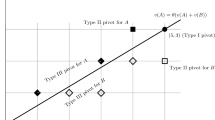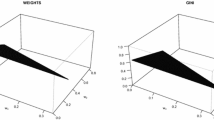Abstract.
Using the voting procedure proposed by Baron (1996), the consequences are examined of changing the majority required to change legislation. When the majority required is greater than fifty percent, and when voters behave strategically, the first policy proposed (on a stationary equilibrium path) is never defeated subsequently. Which policy gets proposed first depends on which voter gets to make the first proposal. But increasing the required majority induces a mean–preserving spread on the distribution of these policies, if voters' types are distributed symmetrically. Thus before the voting procedure begins, voters would prefer unanimously to see the required majority reduced.
Similar content being viewed by others
Author information
Authors and Affiliations
Corresponding author
Additional information
I would like to thank an anonymous referee, and an associate editor of this journal, for very helpful comments.
Rights and permissions
About this article
Cite this article
Bucovetsky, S. The optimal majority with an endogenous status quo. Soc Choice Welfare 21, 131–148 (2003). https://doi.org/10.1007/s00355-003-0208-z
Received:
Accepted:
Issue Date:
DOI: https://doi.org/10.1007/s00355-003-0208-z




